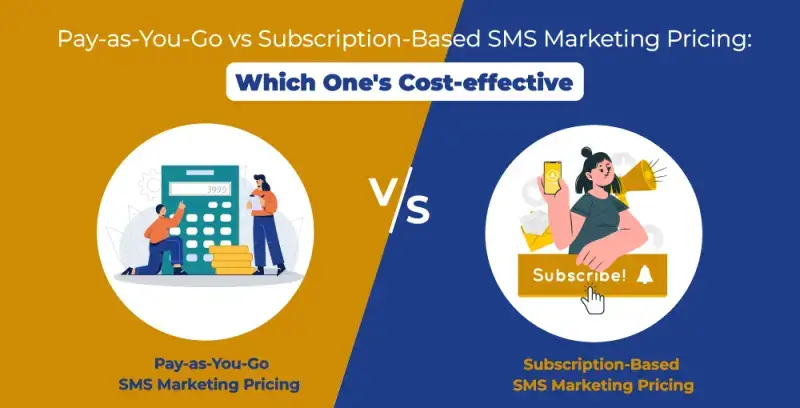
04 Jul 2023

Nicole Esters


04 Jul 2023

Nicole Esters
With a high open rate and conversion rate of SMS, businesses have actively started leveraging the SMS channel quite recently. And tools like Textdrip help you capture the popularity of text messages to run automated drip campaigns, schedule messages, respond quickly, distribute leads, and do many more things.
However, when it comes to choosing the right mass texting tool, most people research and compare various aspects. One of the most compared aspects is SMS marketing pricing & costing.
What intrigues me is that many industry players follow different pricing models, which is a bit confusing as users have no idea which one’s the most cost-effective. In this article, I’ll delve into the SMS marketing pricing comparison to give you an idea of which one’s most suitable for your small business.
So, let’s get started by first understanding the different pricing strategies used:
Basically, there are two types of pricing models adopted by most SMS marketing software providers. These include Pay-as-You-Go and Subscription-based pricing models. Apart from these, if you combine both, you’ll get a hybrid pricing model that many small business SMS marketing platforms follow.
Getting confused? Let me explain what each entails:
The pay-as-you-go pricing model is where you’d pay the charges based on your usage of the platform and the number of SMS credits you utilized in a month. Here, instead of committing for a whole month or a year, you pay only for the SMS credits you plan to use for the next week, month, or year.
The pricing model typically works by purchasing message credits, where one credit is used for sending one SMS segment of 160 characters. Sending longer text messages and MMS messages costs extra. Once you have exhausted your credits, you’ll need to replenish your account by purchasing additional credits.
The cost of purchasing one SMS credit can vary depending on a number of factors such as SMS number provider, platform functionalities, destination country, and others. Due to these factors, the cost of SMS marketing with this pricing model tends to be sometimes higher than the other pricing strategies.
For instance, depending on the tool, it can cost $0.024 to $0.049 per credit or more, which is 2 to 4 times higher than the Textdrip credit purchase cost .
Despite such differences, pay-as-you-go offers several benefits:
Such type of pricing is best suited for industries that don’t have predictable text message requirements. For instance, industries like real estate , healthcare, insurance , travel & tourism, and others can benefit from these as they don’t have the predictability of how many messages they’d need to send in the next week or month.
Subscription-based SMS marketing platforms require users to pay an upfront subscription fee (monthly/annually) and offer a fixed number of monthly message credits. This type of pricing model is generally best suited for businesses with predictable and consistent messaging needs.
Typically, this pricing covers fees for platform charge, additional features, SMS quotas, and others. Such benefits and SMS quota vary depending on the plan you choose and the level of service you require. Here, you are provided with multiple tiered pricing options to choose from based on your requirement.
Each plan has a fixed subscription cost, which depends on factors like the number of admin users, additional features, expanded SMS quotas, target country, and others. Since it works on a fixed-cost pricing method, it helps businesses predict how much they’ll be spending each month.
However, the major drawback of this pricing strategy is you can only send a predetermined number of text messages. And if your needs exceed the fixed SMS quota, you’ll have to pay additional charges for each message or each credit utilized.
This can make it a little costly for small-scale businesses that want to send more messages to their large sets of audiences. This makes it less flexible than the pay-as-you-go pricing model, forcing you to upgrade to higher-tier plans or pay extra charges for additional messages you send.
For instance, depending on the tool and pricing tier you choose, it can cost $20 to $1250 for sending 500 messages and goes up to 50,000. Also, the additional credits can cost from $0.02 to $0.055 per credit depending on your plan. This is still nowhere near to what Textdrip offers.
Though the benefits of subscription-based text message marketing pricing include:
This type of pricing works best for industries such as eCommerce, logistic services, recreation services, etc. where they have a general idea of how many messages they’d be sending in the next week or month.
Most text message marketing tools in the market follow one of the two pricing models explained above. Only a few software like Textdrip follow a hybrid model combining elements from both SMS marketing pricing strategies.
But won’t this make these tools more expensive?
Well, not exactly. Let me explain here why.
Tools with pay-as-you-go pricing don’t charge platform and other fees, and thus have to cover the extra costs by increasing their per-credit charge.
Similarly, tools with subscription-based pricing don’t provide the flexibility of pay-as-you-go. Thus, you may have to spend extra to buy additional credits over and above the provided in the selected plan, which is also expensive.
However, tools with hybrid pricing remove such hurdles and provide you with the flexibility of a pay-as-you-go model so you can purchase as many credits as required at a nominal charge. Also, tools like Textdrip have a relatively low monthly subscription charge for the platform, phone number, and others.
For instance, Textdrip has a simple pricing structure of $19.99 per month with 2 credits per SMS, priced at $0.024 per message that plan includes 2 credits for each SMS, with the cost per message set at $0.024. This clear and simple structure makes it easy for businesses to budget their SMS marketing efforts without unexpected fees or complications.
This makes Textdrip one of the most cost-effective tools in the market with all the essential features needed to automate your SMS marketing campaigns. Also, tools with this pricing model can work for all types of industries as it offers flexibility to scale up and down their messaging efforts depending on their needs.
Now that we have learned the different text message marketing pricing strategies, the question is which one’s the most cost-effective for your business.
Well, if you have read the above strategies, you’d know by now that tools with a hybrid pricing strategy tend to be the most cost-effective than others.
The reason is simple, tools with pay-as-you-go pricing are 2 to 4 times more expensive while subscription-based tools also charge higher for additional credit purchases over and above the provided limit.
Textdrip, for instance, follows the hybrid SMS marketing pricing model combining the benefits of both tools. You can book a demo of the Textdrip to know more about what features it includes and how it can be cost-effective for your business.
Also, you can talk to our sales staff for more information about Textdrip pricing or SMS mobile marketing platform pricing and how it’ll be a great addition to your marketing strategy.